
![]()
Search the Journey to Forever website – click HERE
|
Journey to Forever: Make a donation |
Navigation
| Small farms library | |
| City farms | |
| Organic gardening | |
| Journey to Forever organic garden Handmade soil Village development |
|
| Why organic? | |
| Do it for selfish reasons No pesticides Food quality |
|
| Building a square foot garden | |
| Where to build it Is the soil fertile enough? Raised beds and double-digging The lazy way Paths The sides Sizes and shapes Trellises Cement Soil No compost? |
|
| Plant spacing guides | |
| No ground? Use containers | |
| Container gardening guide Resources |
|
| When to sow what | |
| Sowing times for different regions Seed sowing and harvesting times for Hong Kong Vegetable Garden Calendar for Hong Kong |
|
| Seeds | |
| Catalogs Supplies Herbs Hong Kong |
|
| Garden pond | |
| Pond resources | |
| Gardening resources | |
| Organics resources | |
| Square foot gardens | |
| Companion planting | |
| How much to grow? | |
| General gardening | |
| Herbs | |
| Composting | |
| Small farms | |
Contact usTo Keith Addison Handmade Projects |
Gardening resources
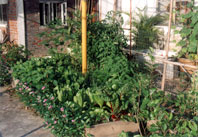
Part of the Journey to Forever square foot garden
Square Foot gardening resources

Part of the Journey to Forever square foot garden
See also: Building a square foot garden
Plant spacing guides
A Square Yard in the School Yard -- The square foot gardening guide for teachers is a good general guide for square foot beginners:
http://www.farmerbrown.org/manual.html
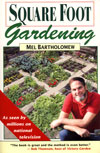 "Square Foot Gardening: A New Way to Garden in Less Space with Less Work" by Mel Bartholomew, 1981 — "Best selling gardening book in America. Over 1 million copies sold to date." 347 pgs. Illustrated. "Grow a perfect garden in only 10 minutes a day." Buy at Amazon.com: Square Foot Gardening
"Square Foot Gardening: A New Way to Garden in Less Space with Less Work" by Mel Bartholomew, 1981 — "Best selling gardening book in America. Over 1 million copies sold to date." 347 pgs. Illustrated. "Grow a perfect garden in only 10 minutes a day." Buy at Amazon.com: Square Foot Gardening
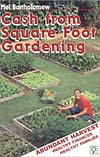 "Ca$h from Square Foot Gardening" by Mel Bartholomew, Square Foot Press, 2000, 250 pages -- Square foot gardening as a sideline selling vegetables to restaurants. Bartholomew shows how gardeners can expand from a small-scale start to provide 20 to 30% of a restaurant's vegetable supplies. Planting times, spaces, profits (from $1-$5 per sq ft), and more. Better source than the first book on how to use the Square Foot system to grow food. Buy at Amazon.com: Ca$h from Square Foot Gardening
"Ca$h from Square Foot Gardening" by Mel Bartholomew, Square Foot Press, 2000, 250 pages -- Square foot gardening as a sideline selling vegetables to restaurants. Bartholomew shows how gardeners can expand from a small-scale start to provide 20 to 30% of a restaurant's vegetable supplies. Planting times, spaces, profits (from $1-$5 per sq ft), and more. Better source than the first book on how to use the Square Foot system to grow food. Buy at Amazon.com: Ca$h from Square Foot Gardening
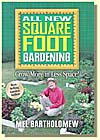 The All New Square Foot Gardening Book, by Mel Bartholomew -- History of Square Foot Gardening, the basic principles, quick start guide, more plant resources, charts showing growth rate, illustrated "How-To" and "Step-By-Step" approach anyone can understand. Buy at Amazon.com: The All New Square Foot Gardening Book
The All New Square Foot Gardening Book, by Mel Bartholomew -- History of Square Foot Gardening, the basic principles, quick start guide, more plant resources, charts showing growth rate, illustrated "How-To" and "Step-By-Step" approach anyone can understand. Buy at Amazon.com: The All New Square Foot Gardening Book
Colin Shaw's UK "Square Foot" Gardening Pages -- Lots of information here! "I have been using the Square Foot method for several years now and am still amazed at just how successful it is. It is a very easy way to start growing organic vegetables without taking up much space in the garden." Good place to start learning about square foot gardening, adding the essential element of organic gardening, weak or missing in some other square foot resources -- composting, companion planting and more. Start now!, resources, courses, links, books, SqFt Forum.
http://www.organicgarden.org.uk/SqFt/index.htm
Square foot gardening tips:
http://www.organicgarden.org.uk/SqFt/sqfttips.htm
List of Plant Spacings for Square Foot Gardens:
http://www.organicgarden.org.uk/SqFt/sqftspacings.htm
Check the organics resources on Organic-UK's home page:
http://www.organicgarden.org.uk/
Neighborhood Gardens -- Lots of photographs of square foot gardens all over the US and Canada, at the Square Foot Gardening site
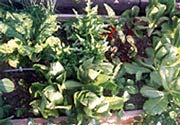
Different varieties of lettuce growing in their squares, at the Journey to Forever square foot garden
http://www.squarefootgardening.
com/NeighGarden.htm
Square Foot Garden Manager -- PC software
Garden Manager 3.0, WinSite Package -- What did you plant in that square last year after you pulled out the beans? Useful management and record-keeping shareware program written by square foot gardener Jonathan Maier (PCs only). Download site:
http://www.winsite.com/bin/Info?500000025691
Square Foot mailing lists and forums
Join the squarefootgardening group at Yahoo!Groups:
http://groups.yahoo.com/group/squarefootgardening/
The Garden Web Square Foot Gardening Forum
http://forums.gardenweb.com/forums/sqfoot/
Square Foot Garden forum at Ft2Garden.com
http://ft2garden.com/messageboards/viewforum.php?
f=26&sid=ae8fe3d1eb14cabe3f008ea75f88fa38
The original Square Foot Gardening list is now inactive -- archive of old messages from 1997:
http://www.hort.net/lists//inactive/sqft/
Square Foot gardens for schools
A Square Yard in the School Yard -- a guide for teachers. Detailed guide for teachers to start Square Foot Gardens for their students, even with no gardening experience.
http://www.farmerbrown.org/manual.html
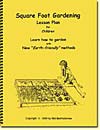 Square Foot Gardening: Lesson Plan for Children -- Learn how to garden with new "Earth-friendly" methods
Square Foot Gardening: Lesson Plan for Children -- Learn how to garden with new "Earth-friendly" methods
Children's Lesson Plan and Teaching Guide for parents or teachers, for home or school, for ages 8 to 18. Projects include backyard garden, family history, Internet, field trips, self discovery, science project, vocabulary skills, math challenges, skill activities. 55 pgs. Illustrated. Sample lesson pages online.
http://www.squarefootgardening.com/html/catalog/book2.html
School gardening, For Kids Only -- Square Foot Gardening Kids games, School Garden Contest, Teaching advice.
http://www.squarefootgardening.com/html/body_for_kids_only.html
Teaching Square Foot Gardening -- Recommended teaching references, teaching props, what-is and how-to handouts for students.
http://www.squarefootgardening.com/html/body_what_s_new7.html
Companion planting
"Companion planting helps bring a balanced eco-system to your landscape, allowing nature to do its job" -- not a chart, this is an extensive list of good companions with descriptions of how to use them, from Golden Harvest Organics in Colorado.
http://www.ghorganics.com/page2.html
Vegetable Companion Chart from GardenGuides' Tips and Techniques
http://www.gardenguides.com/TipsandTechniques/vcomp.htm
Companion Planting: Basic Concepts & Resources, from ATTRA, Appropriate Technology Transfer for Rural Areas, in the US. Traditional Companion Planting charts, scientific foundations, good set of references and resources.
http://www.attra.org/attra-pub/complant.html
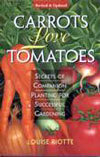 "Carrots Love Tomatoes: Secrets of Companion Planting for Successful Gardening" by Louise Riotte, Storey Books, 2nd edition (March 1998), ISBN 1580170277
"Carrots Love Tomatoes: Secrets of Companion Planting for Successful Gardening" by Louise Riotte, Storey Books, 2nd edition (March 1998), ISBN 1580170277
This gardening classic was first published in 1975. For gardeners who prefer pest-resistant planning to chemicals. Also, how to use herbal sprays to control insects, what wild plants to encourage in the garden, how to grow fruit and nut trees, how to start small plots or window-box gardens. Louise Riotte lists hundreds of plants and their ideal (and less than ideal) companions. Detailed line drawings. Buy at Amazon.com: Carrots Love Tomatoes
How much to grow?
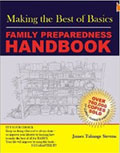 "Making the Best of Basics -- Family Preparedness Handbook" by James Talmage Stevens, 12th edition, 2010, Fulfillment Central Publishing, ISBN-10: 1934275182, ISBN-13: 978-1934275184
"Making the Best of Basics -- Family Preparedness Handbook" by James Talmage Stevens, 12th edition, 2010, Fulfillment Central Publishing, ISBN-10: 1934275182, ISBN-13: 978-1934275184
The preparedness bible -- how to live on your own resources for up to a year, regardless. First published in 1974, this is still the most comprehensive book on the subject. 760,000 copies sold. This new edition has been updated with 250 new pages of charts, tables and information. The focus is on food: "Store what you eat, eat what you store, use it or lose it." Thorough. Available in both a printed version and as a digital download e-book. Comes with a free 90-minute online video. Anybody who's interested in food will benefit from this book. Buy the book: Making the Best of Basics
Self-sufficiency -- how much to grow to feed a family of five, in very little space.
http://www.organicgarden.org.uk/
growing/grow/plantplan.html
The Michigan State University Preserving Food Database lists the number of feet of row to plant for one person for each vegetable. Carrot Facts: Availability: mid July through October; Days to Maturity: 70-80 days; Approximate Yield/10 feet of row: 10 pounds; Per Person Requirements: Fresh: 5-10 feet of row, Preservation: 10-15 feet of row.
http://www.msue.msu.edu/msue/imp/mod01/master01.html
General gardening
The Garden Gate is a prime online resource for gardeners. The Gardener's Guide to Finding Answers on the Internet; the Teaching Garden -- extensive and well-organized collection of glossaries, FAQs, special topic WWW pages, collections, and plant lists; Gardener's Guide to Mailing Lists; Gardener's Reading Room: e'zines, magazines online, magazine info, catalog info, catalogs online, book sources and reviews; Garden Shop, search, links to everything.
http://garden-gate.prairienet.org/
GardenWeb says it's "the premier gateway to gardening on the Internet." It's certainly comprehensive, with a huge set of well-organized links to resources for gardeners.
http://www.gardenweb.com/
GardenWeb gardeners' online forums -- GardenWeb claims to host the largest community of international gardeners on the Internet. Forums on a wide variety of gardening topics.
http://forums.gardenweb.com/forums/
The Gardening Launch Pad -- Master Composter and National Flower Show Judge Jim Parra's Launch Pad has thousands of gardening links in 100 categories, focus on the Home Gardener, 96% of these links are content links, not commerical links.
http://www.gardeninglaunchpad.com/
California Rare Fruit Growers (CRFG) is the largest amateur fruit-growing organization in the world. Fruit Facts online -- botanical identification, plant description and culture notes, characteristics of cultivars for 43 fruit varieties -- Common Names, Origin, Species, Related species, Adaptation; Description: Growth Habit, Foliage, Flowers, Fruits; Culture: Location, Soil, Irrigation, Fertilization, Frost Protection, Pruning, Propagation, Pests and Diseases, Fruit Harvest; Cultivars; Further Reading, and a direct link to Index of CRFG Publications, 1969--89. Also The Fruit Gardener magazine, descriptions of 250 rare and unusual edible plants, Seed Bank, the CRFG Fruit List -- Common Name, Genus species, Family, and Fruit Cultural Data, by genus name. Plus a large set of fruit and related links. Exhaustive! Excellent resource.
http://www.crfg.org/
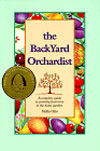 "The Backyard Orchardist: A Complete Guide to Growing Fruit Trees in the Home Garden" by Stella Otto, revised edition 1995, Otto Graphics, ISBN 0963452037
"The Backyard Orchardist: A Complete Guide to Growing Fruit Trees in the Home Garden" by Stella Otto, revised edition 1995, Otto Graphics, ISBN 0963452037
Step-by-step guidance from a true expert on how to start your orchard -- planning, soil, tree selection for your climate, planting, pruning, pest management, harvesting and storing, everything you need to know. Buy at Amazon.com: The Backyard Orchardist
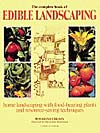 "The Complete Book of Edible Landscaping" by Rosalind Creasy, 1982, Sierra Club, ISBN 0871562782
"The Complete Book of Edible Landscaping" by Rosalind Creasy, 1982, Sierra Club, ISBN 0871562782
Thorough treatment, practical, how-to advice from a seasoned landscape designer and consultant, well-illustrated. Energy, water and soil-saving techniques for different regions. Includes a 160-page encyclopaedia of edible plants with cultural details, landscaping, culinary uses, sources and recipes. Large list of plant and seed suppliers. "Head and shoulders above the rest" of the books on this subject, says a master gardener. Buy at Amazon.com: The Complete Book of Edible Landscaping
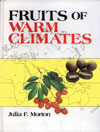 "Fruits of Warm Climates" by Julia F. Morton, ISBN: 0-9610184-1-0
"Fruits of Warm Climates" by Julia F. Morton, ISBN: 0-9610184-1-0
Julia F. Morton is Research Professor of Biology and Director of the Morton Collectanea, University of Miami, a research and information center devoted to economic botany. Covers 124 species, with an extensive bibliography; the entry for each species is a minor essay, with detailed treatment under Description, Origin and Distribution, Varieties, Climate, Soil, Propagation, Culture, Keeping Quality, Pests and Diseases, Food Uses, Other Uses. The approach is global -- Uses, for instance, covers the practices of traditional peoples throughout the world, including medical uses. Ms Morton provides a real wealth of information from her long experience of the subject. With photographs. Full text online:
http://www.hort.purdue.edu/newcrop/morton/index.html
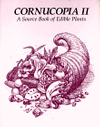 "Cornucopia II -- A Source Book of Edible Plants" by Stephen Facciola, Kampong, ISBN 0962808725
"Cornucopia II -- A Source Book of Edible Plants" by Stephen Facciola, Kampong, ISBN 0962808725
Encyclopaedia of about 3,000 edible plants, alphabetical listing of plant families with 300 pages describing 7,000 varieties, especially traditional and heirloom varieties, and promising new releases. Habitat, origin, cultivation, preparation, modern and ancient uses, and 1,300 sources for seed, plants and rootstock, produce and other foodstuffs. In addition to common and botanical name cross-referencing there is an index of plants listed by use and edible parts. Wonderful work of scholarship. Buy at Amazon.com: Cornucopia II
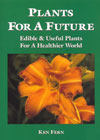 "Plants for a Future: Edible and Useful Plants for a Healthier World" by Ken Fern, 2000, Permanent Publications, ISBN 1856230112
"Plants for a Future: Edible and Useful Plants for a Healthier World" by Ken Fern, 2000, Permanent Publications, ISBN 1856230112
The way we currently produce our food is damaging both to ourselves and our planet. We need to create gardens, woodlands and farms which are in harmony with nature. What we need is to discover and grow a wide variety of easily grown perennial and self-seeding annuals which provide delicious and healthy food, or are useful in other ways. Describing plants such as these, native to Britain and Europe and from temperate areas around the world, this book includes those suitable for: the ornamental garden, the edible lawn, shade, ponds, walls, hedges, agroforestry and conservation. Packed with information, personal anecdote and detailed appendices and indexes, this pioneering book takes gardening, conservation and ecology into a new dimension. "Ken Fern leads us through a garden of improbable delights -- cold climate yams five feet long, edible fuschia fruits, trees laden with delicious berries all through the winter, leaves and flowers with the most subtle and astonishing flavours. It is hard to over-estimate the importance and likely impact of this book. The result of an insatiable curiosity and years of painstaking research, this book is comparable in stature only to the works of Evelyn and Culpeper." -- George Monbiot, The Guardian. Buy at Amazon.com: Plants for a Future
See the Plants For A Future online database.
Mother Earth News Online -- Best stories over 30 years of getting back to the land (online), current issue, site search.
http://www.motherearthnews.com/
The History of Gardening Timeline from Ancient Times to the 20th Century -- "Noteworthy Publications, Persons, and Events in the History of Gardening. Including some Related Information from Agriculture, Natural History, Botany, and Ecology." This award-winning site tells a fascinating story and tells it well, starting 10,000 years ago -- From Ancient Times to 1700, the 18th Century, the 19th Century, the 20th Century, plus a great list of reference sources. Part of Mike Garofalo's The Spirit of Gardening website, a great place for gardeners.
http://www.gardendigest.com/timetab.htm
Plant databases
The New Crop Resource Online Program at Purdue University, includes CropSEARCH -- a key word search engine to access crop information, 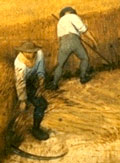 CropINDEX -- a list of scientific and common names of crops for information access, CropREFERENCE -- books and manuals on crops, Aromatic-MedicinalPLANTS -- a guide to aromatic & medicinal plants, culinary herbs & spices, NewCrop LISTSERV -- an interactive bulletin board for queries, discussion, and information on crops, and much more. Easy access to a huge set of resources on crops new and old, trees, plants of all kinds. "The most comprehensive library and compilation of new and alternative crop information available on the web." Very useful indeed.
CropINDEX -- a list of scientific and common names of crops for information access, CropREFERENCE -- books and manuals on crops, Aromatic-MedicinalPLANTS -- a guide to aromatic & medicinal plants, culinary herbs & spices, NewCrop LISTSERV -- an interactive bulletin board for queries, discussion, and information on crops, and much more. Easy access to a huge set of resources on crops new and old, trees, plants of all kinds. "The most comprehensive library and compilation of new and alternative crop information available on the web." Very useful indeed.
http://www.hort.purdue.edu/newcrop/
Plants For A Future -- A resource centre for edible and other useful plants. Database Search has a variety of powerful searches of very large plant resources. Search by Name (common or family), Edible, Medicinal or Other Use, Native Area, Habitat, word search, Latin names. You can download the database for your own use. Home page:
http://www.comp.leeds.ac.uk/pfaf/index.html
Search page:
http://www.ibiblio.org/pfaf/D_search.html
Poisonous Plants at Cornell University's Animal Science Department includes plant images and information on the botany, chemistry, toxicology, diagnosis and prevention, linked to related resources. Database search.
http://www.ansci.cornell.edu/plants/
See also Herb databases below.
Herbs
-- "Herbs and plants are medical jewels gracing the woods, fields and lanes which few eyes see, and few minds understand. Through this want of observation and knowledge the world suffers immense loss." -- Linnaeus 1707--78
"Culpeper: The Complete Herbal" by Nicholas Culpeper, 1653 -- "being an astrologo-physical discourse of the common herbs of the nation; containing a complete Method or Practise of Physic, whereby a Man may preserve his Body in Health, or cure himself when sick, with such things only as grow in England, they being most fit for English Constitutions." Dr Johnson said: "Culpeper, the man that first ranged the woods and climbed the mountains in search of medicinal and salutary herbs, undoubtedly merited the gratitude of posterity." And received it -- the Herbal was the basis of all subsequent herbalism in the English-speaking world, and has probably never been out of print in 350 years. And now it's online.
http://www.bibliomania.com/NonFiction/Culpeper/Herbal/
A Modern Herbal, 1931, by Mrs. M. Grieve. Over 800 varieties of medicinal, culinary, and cosmetic herbs, including economic properties, cultivation and folk-lore, online in hypertext, with a word search of all 860 pages.
http://www.botanical.com/botanical/mgmh/mgmh.html
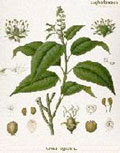 Köhler's Medizinal Pflanzen (Kohler's Medicinal Plants) -- wonderful botanical illustrations online. Large images.
Köhler's Medizinal Pflanzen (Kohler's Medicinal Plants) -- wonderful botanical illustrations online. Large images.
http://caliban.mpiz-koeln.mpg.de/
~stueber/koehler2/index.html
Richters Herbs -- Medicinal, Culinary, Aromatic. This is a great website, packed with information on the wonderful subject of herbs. Also publishes Richters HerbLetter, sent to you by email, a real treasurehouse, top of its class by far.
http://www.richters.com/
Herb World is the website of the Herb Growing & Marketing Network, a trade association with around 2,000 members, and acts as an information service for members (and anyone else). Features The Herbal Green Pages Online, Herbal Exchange, Botanical Dictionary, Herb Source, Potpourri (great links to informational herb sites), Herbal Exchange, the Herbalpedia monthly monograph series.
http://www.herbworld.com/
Herb databases
The Guide to Medicinal and Aromatic Plants at Purdue University's Center for New Crops and Plant Products includes Plant/Crop Descriptors -- information about each herb plant in alphabetical order by common and Latin names; Plant/Crop Production Guides -- in-depth fact sheets; Guide to Herb Varieties -- herb varieties available from commercial sources; Sources of Herb Seeds and Plants, research archive, citations database, Other Sources/References, links, Directory of Experts.
http://www.hort.purdue.edu/newcrop/med-aro/default.html
Phytochemical and Ethnobotanical Databases -- Dr James Duke is a foremost expert on medicinal plants, and his site (hosted by the US Agricultural Research Service) contains an amazing collection of herbal knowledge. Excellent resource.
http://www.ars-grin.gov/duke/index.html
Gardening resources
Organics resources
Square foot gardens
Companion planting
How much to grow?
General gardening
Herbs
City farms
Organic gardening
Why organic?
Building a square foot garden
Plant spacing guides
No ground? Use containers
When to sow what
Seeds
Garden pond
Gardening resources
Composting
Making compost
Composting resources
Composting indoors
Vermicomposting
Humanure
Composting for small farms
Small farms
Small farm resources
Community-supported farms
Farming with trees
Farming with animals
Pasture
Pigs for small farms
Poultry for small farms
Aquaculture for small farms
Composting for small farms
Controlling weeds and pests
Small farms library